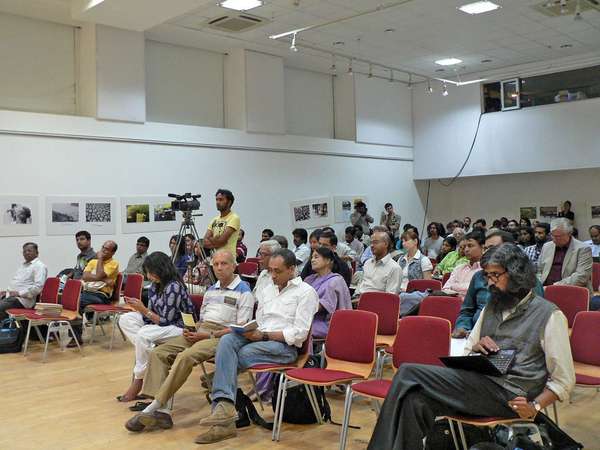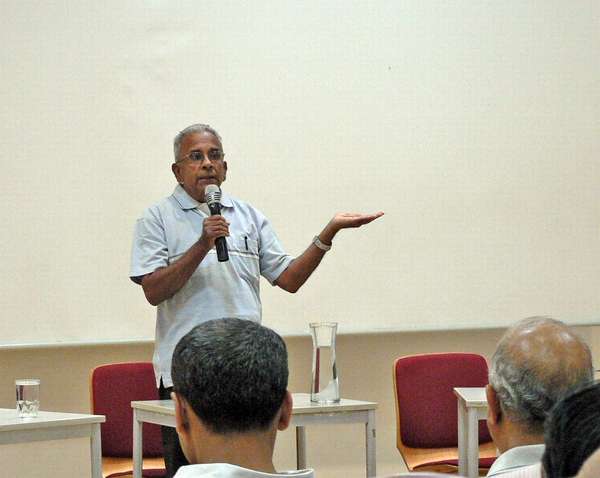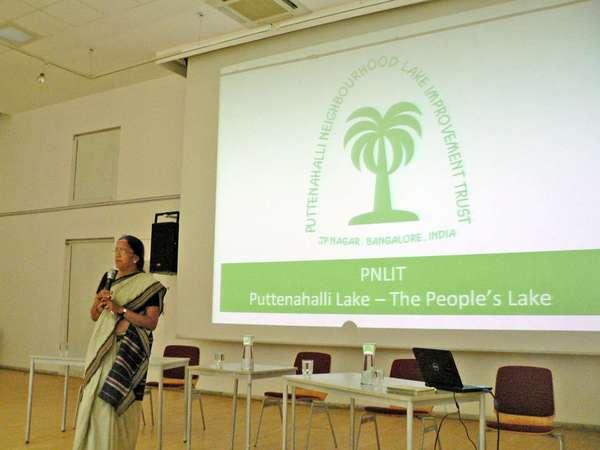Is Bangalore hosting way too many talks and seminars and not showing much action on ground? Many seem to think so. But Usha Rajagopalan’s talk was infectious enough to get us all on our feet to go home and save water and our water bodies nearby.
An interactive panel discussion, “Water Matters: 1.3 billion litres/day – Where do we go from here?” was organised by ‘The Alternative‘ on Friday, March 22, 2013 at Max Mueller Bhavan. The panelists included Usha Rajagopalan (A founding member of the Puttenahalli Neighbourhood Lake Improvement Trust (PNLIT)), Sekhar Raghavan, the first trustee of the Akash Ganga Trust (Rain Centre) at Chennai, Thippeswamy M N, ex-Chief Executive Engineer at BWSSB and the well known ‘zenrainman‘ S Vishwanath of Rainwater Club, Bangalore.
The ‘World Water Day’ event organised by ‘The Alternative’.jpg. Pic: Shamala Kittane
August 2003 was the deadline, mandating Rainwater Harvesting (RWH) for all properties in Tamilnadu, set by the then Chief Minister of Jayalalitha. It looked as if the weather gods were determined to prove Amma right in her insistence on RWH, even as the state suffered severe drought in 2003-04. Raghavan says, “Most of Tamil Nadu (houses) had rainwater harvesting installed by then. Although only 50% understood the reasoning behind it, they did a (proper) job of designing rainwater harvesting structures on their premises”.
Within two years, the impact was visible when Rain Centre carried out its survey of groundwater in 2005-06 in Chennai. Groundwater had risen by about 6 meters than previous records, 39 temple tanks in Chennai were full in Jan 2006. “These temple tanks until then were used to play cricket.” he adds.
Sekhar Raghavan telling us about RWH. Pic: Shamala Kittane
Clarifying that he is not politically biased, Raghavan admires the AIADMK’s efforts in making the RWH drive fairly successful in Chennai. Going back to his data of only 50% success ratio, Raghavan laments that RWH is now going south, with reduction rate of 30-40% in recent years.
In its recent appeal, the Rain Centre has requested the government of Tamil Nadu for a third party monitoring body to ensure that all RWH structures are designed and maintained well and continue to be functional and mandatory. From his experience, he feels every city must have a Rain Centre to make people water-sensitive by spreading awareness on the need for RWH. “It’s time to tap on the doors and talk to people about water. Not just that, we need to learn to live with less water and thus give it the respect it deserves”.
When Usha pointed to the fast shrinking Puttenahalli Lake, by approaching her neighbours at L&T South City, the typical response she got was, “Why? We are paying our taxes. Let the government do its duty.” “But the government wouldn’t even know of the existence of this small lake,” was Usha’s response.
“It is alright to die without water, but to die without fighting to save it is a shame,” says Usha, whose genuine concern and positive attitude won the initial resistance in the year 2008 to save Puttenahalli Lake that is now full of life, backed by the residents of L&T South City, Arekere and Brigade Millennium, JP Nagar. The revival of the lake started in 2010 and in 2011 BBMP handed over the lake (of the 13 lakes identified by BBMP for restoration and conservation) to the trust formed by Usha and fellow residents Arathi Manay, Prasanna K. Vynatheya, O.P. Ramaswamy and Nupur Jain.
Usha Rajagopalan. Pic: Shamala Kittane
The cost of water has a key impact on how much you treat water. Vishwanath says, “If people pay Rs 80 per kilolitre of water then the ecological cost of water is taken care of. If water comes to you at that cost, you will start question the need to pump water from far away at such high ecological costs and looking at local water resources and water that falls from the skies instead of getting it from far away which is ecologically damaging and economically unjustified”
Panel discussion moderated by Ayaan of Arghyam.jpg. Pic: Shamala Kittane
Locally available resources
The tributaries of Cauvery (Arkavathy, Kumudavathy and Vrishabavathy) that run across the city are now drainages. A few small groups of people have been working towards reviving them. Thippeswamy, one of the members of ‘Arkavathy Punaschethana’ group, talked about the tanks in Hesarghatta and Thippegondanahalli.
“The change in land use patterns in the neighbouring areas where forests have been replaced by huge concrete structures and deep set borewells is running the tanks dry,” Thippeswamy explained. Niyamatullah Khan from the audience, retired Groundwater Geologist seconded this theory of changing land use patterns causing reduction in water seepage from surface to underground aquifers.
Vishwanath lauded the BWSSB and BESCOM’s WENEXA program (Water and Energy Nexus) that includes making pump sets in Doddaballapur region energy efficient. They have set up an Efficient Irrigation Promotion cell to promote drip/sprinkler irrigation systems, thus saving water pumped from borewells. He said this kind of model can be implemented for rejuvenation of Arkavathy. His team is working on replenishing five tanks that contribute to Arkavathy with help from the government of Karnataka, and have successfully rejuvenated one tank.
Raghavan felt that residents suffer from a colonial hangover. “Village communities who used the water resources in their villages also naturally took it upon themselves as their duty to protect them. This practice existed until the British wedged in a third organisation solely responsible for taking care of the water bodies – the PWD department. We continue this practice, but PWD department does nothing to protect the water resources now.”
What sort of rainwater harvesting?
Raghavan said, “People need to get out in the rain and observe it. If you see that open spaces around your house are capable of absorbing water and that too much water is not flowing off, then its probably best to leave it open and plant some trees. But for clayey soil conditions recharge structures are a must and make most sense. In any case observe the rains and you’ll know what’s the best way to recharge your groundwater.”
In response to a question about LDA’s (Lake Development Authority) role and responsibility, Vishwanath said that there is a fundamental problem with the institutional construct of the government departments. LDA has forest officials, BWSSB does not have any geological experts. Water resources are split across different government authorities as ground water, pipe water, rain water, lakes etc. What is needed is a single department that will work on all aspects of water which would solve many water related issues.
“There are about 30-35 lake groups in the city now that have realised the value and importance of protecting the lakes in their neighbourhood,” said Usha. The discussion ended with a positive note.⊕



